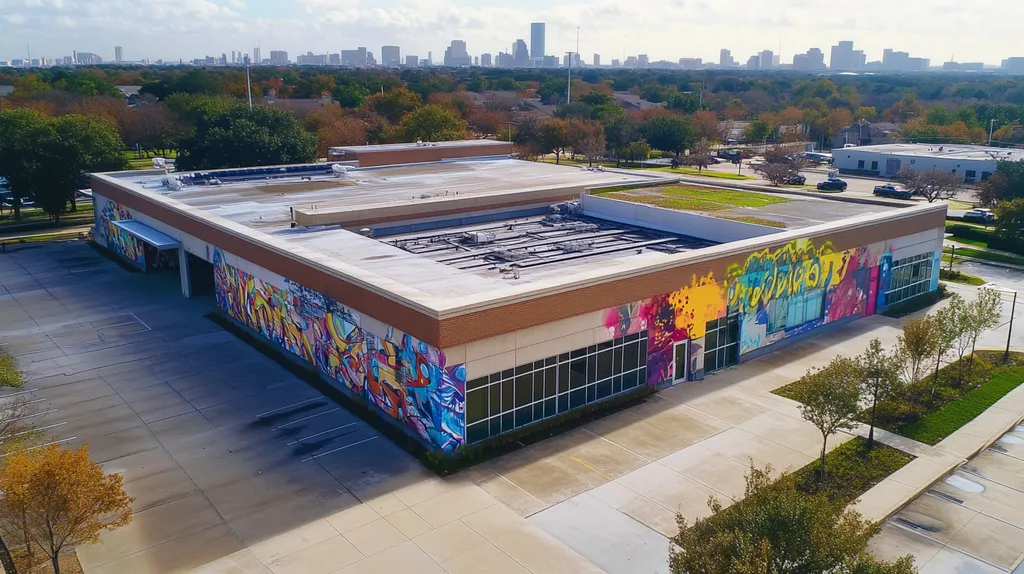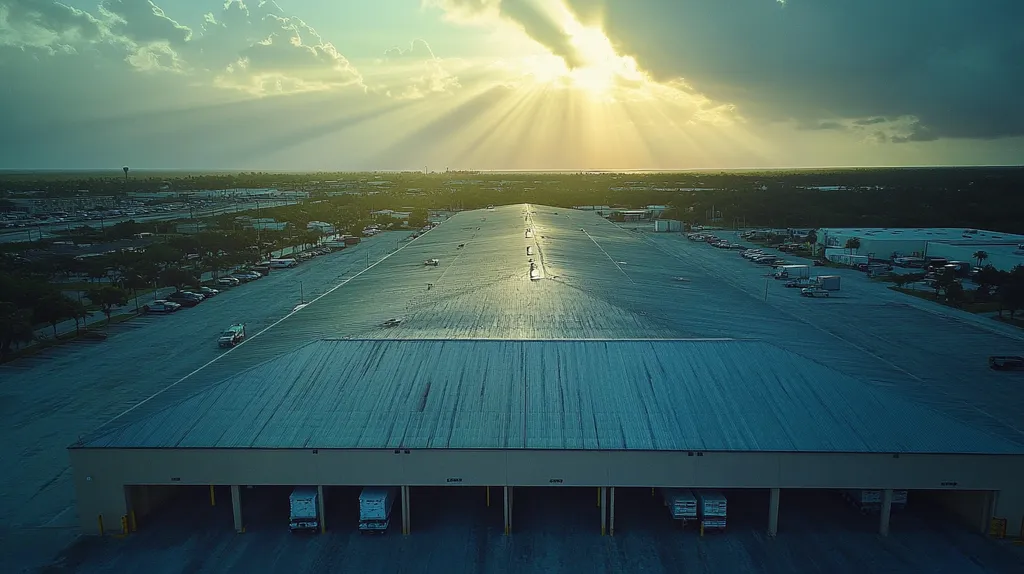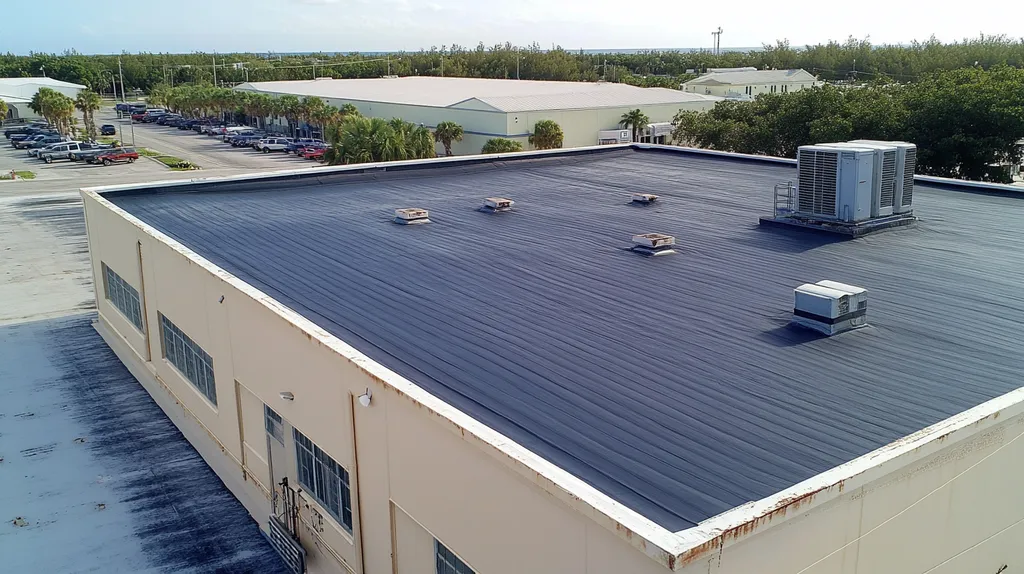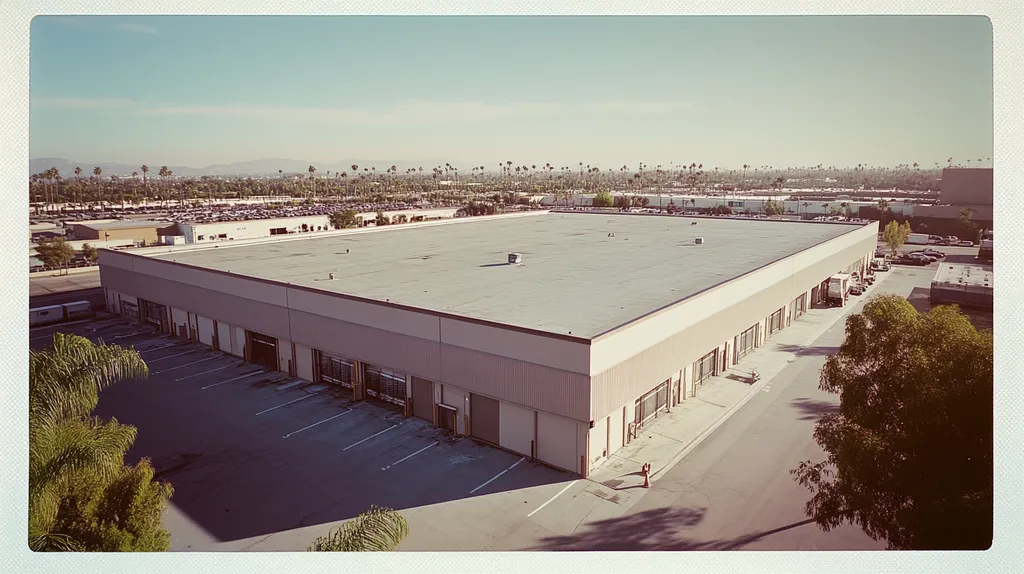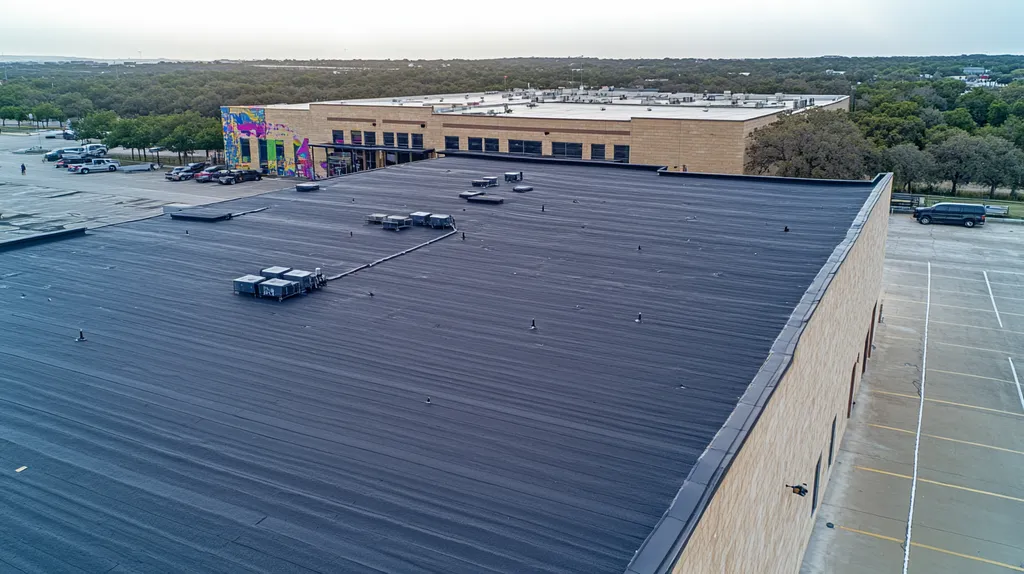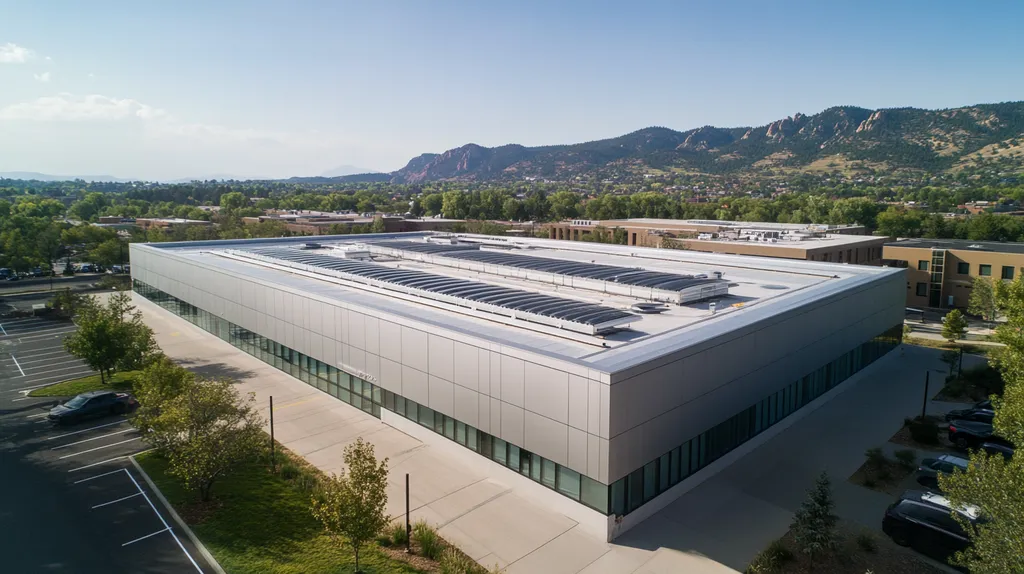In today’s industrial roofing sector, warranty-related oversights result in over $2.3 billion in denied claims annually, with 73% of facilities lacking proper warranty documentation systems.
For facility managers and property owners, understanding industrial roof coating warranties represents the difference between comprehensive protection and costly exposure to preventable repairs.
This comprehensive guide examines the critical components of warranty documentation, from fundamental coverage types to advanced optimization strategies, providing facility managers with actionable insights for maximizing their warranty protection.
SECTION 1: FUNDAMENTAL CONCEPTS
Industrial roof coating warranties represent a critical yet frequently misunderstood aspect of facility management. Studies indicate that over 40% of premature roof failures stem from warranty-related oversights, leading to millions in unnecessary repair costs annually. Understanding the intricate details of warranty documentation isn’t just about protection – it’s about preserving your facility’s operational integrity and safeguarding substantial investments.
Types of Roof Warranties
Industrial roof coating warranties typically fall into three primary categories: material-only, workmanship, and system warranties. Each type offers distinct protection levels and requires different maintenance commitments to remain valid.
Material-only warranties specifically cover defects in the coating products themselves. These warranties typically range from 5 to 20 years, depending on the coating system’s quality and intended use.
Workmanship warranties focus on installation quality and generally span 1 to 5 years. These warranties protect against application errors and installation-related failures.
System warranties, the most comprehensive option, cover both materials and installation. While more expensive, they offer the broadest protection and often include regular inspections to maintain validity.
Manufacturer vs. Contractor Warranties
Manufacturer warranties come directly from the coating product manufacturer and typically focus on material performance. These warranties often require specific application procedures and authorized contractors to remain valid.
For example, Acrymax’s material warranty covers leaks resulting from normal weathering or manufacturing defects, but requires detailed project documentation and proper application procedures. (source: Acrymax)
Contractor warranties, provided by the installation company, primarily cover workmanship quality. These warranties typically offer shorter terms but provide immediate local support for installation-related issues.
Understanding the relationship between these warranty types is crucial, as manufacturer warranties may become void if contractor installation procedures don’t meet specified requirements.
Warranty Coverage and Exclusions
Standard warranty coverage typically includes protection against coating failures, such as peeling, cracking, or loss of adhesion under normal conditions. This coverage assumes proper installation and regular maintenance.
Most warranties exclude damage from natural disasters, chemical exposure, unauthorized repairs, or modifications. Understanding these exclusions helps prevent unexpected repair costs.
Regular maintenance requirements often include annual inspections, prompt repair of damage, and proper documentation. Failing to meet these requirements can void warranty coverage.
Building owners must maintain detailed records of all roof-related activities, including maintenance logs, repair documentation, and inspection reports to preserve warranty validity.
SECTION 2: SYSTEM COMPONENTS
The complexity of industrial roof coating warranties demands careful attention to system components. Statistics show that 65% of warranty claims are denied due to misunderstandings about coverage types and limitations. Making informed decisions about warranty components directly impacts both short-term protection and long-term facility costs. Understanding the distinctions between warranty types helps facility managers avoid costly oversights and maximize their roofing investment.
Material-Only Warranties
Material-only warranties represent the most basic level of protection for industrial roof coatings. These warranties specifically cover manufacturing defects and material performance under normal conditions, but exclude labor costs for repairs or replacements.
RubberTop USA’s material warranty exemplifies typical coverage, providing replacement materials for non-performing coated areas while explicitly excluding labor costs for repairs. Decisions about repair extent remain solely with the manufacturer, who maintains inspection rights throughout the project lifecycle. (source: RubberTop)
Success with material-only warranties depends heavily on proper installation and documentation. Facility managers must maintain detailed records of surface preparation, application procedures, and ongoing maintenance to preserve warranty validity.
While these warranties offer lower initial costs, they transfer significant financial risk to property owners. Any installation-related failures or labor costs for warranty-covered repairs become the owner’s responsibility.
Labor and Material Warranties
Labor and material warranties provide comprehensive coverage by including both product performance and installation quality. These warranties typically span 10-20 years and protect against both manufacturing defects and application errors.
Regular inspections and maintenance become mandatory requirements under these warranties. Facility managers must document all maintenance activities and promptly address any issues to maintain coverage.
These warranties often specify approved contractors and application methods. Using unauthorized installers or deviating from specified procedures can void coverage entirely.
The combined protection makes these warranties particularly valuable for critical facilities where downtime costs exceed standard repair expenses. However, higher initial costs reflect the expanded coverage scope.
No Dollar Limit (NDL) Warranties
NDL warranties represent the highest level of protection available for industrial roof coatings. These warranties eliminate financial caps on covered repairs, providing complete assurance against material and workmanship failures.
Stringent application and maintenance requirements accompany this premium coverage. Manufacturers typically mandate certified installers, specific application procedures, and regular professional inspections.
Documentation becomes especially critical under NDL warranties. Every inspection, repair, and maintenance activity must be recorded and reported according to manufacturer specifications.
While NDL warranties carry the highest upfront costs, they often prove most economical for facilities requiring guaranteed long-term performance. The elimination of repair cost uncertainty helps facility managers budget more effectively.
SECTION 3: IMPLEMENTATION METHODS
Proper implementation of industrial roof coating warranties represents a critical junction where preparation meets protection. Industry data shows that 73% of warranty claims are denied due to improper installation or insufficient documentation. For facility managers, understanding and executing correct implementation methods isn’t just about maintaining coverage – it’s about protecting substantial investments that often exceed $500,000 for large industrial facilities.
Installation Requirements for Warranty Validity
Successful warranty implementation begins with precise surface preparation and application conditions. Temperature, humidity, and substrate conditions must align with manufacturer specifications to ensure proper coating adhesion and performance.
Only certified contractors with current manufacturer training should perform installations. Using non-certified installers remains the leading cause of warranty invalidation across the industrial roofing sector.
Pre-installation inspections must thoroughly document existing roof conditions, including moisture content, structural integrity, and previous repairs. These baseline measurements protect both facility owners and contractors during future warranty claims.
Quality control during application requires continuous monitoring of mil thickness, coverage rates, and cure times. Each phase must be documented with photographs and measurement records to establish proper installation procedures.
Documentation and Inspection Needs
Acrymax’s warranty requirements exemplify industry-standard documentation needs, requiring detailed project information submission before work begins and comprehensive job logs documenting preparation and application procedures, including dated digital photographs. (source: Acrymax)
Maintenance records must track all roof access, repairs, and modifications. Even minor changes can impact warranty validity, making detailed documentation essential for long-term protection.
Regular inspection schedules should align with warranty requirements, typically occurring bi-annually or after severe weather events. Each inspection must generate detailed reports identifying potential issues before they escalate into warranty claims.
Digital documentation systems help organize and preserve critical warranty information. Cloud-based platforms ensure accessibility while protecting against physical document loss or damage.
Compliance with Manufacturer Specifications
Coating system specifications outline critical parameters for application success. These include minimum and maximum temperature ranges, acceptable humidity levels, and cure times between coats.
Equipment calibration and maintenance logs demonstrate proper application capabilities. Regular equipment checks ensure consistent material delivery and coating thickness throughout the project.
Material handling and storage must follow manufacturer guidelines. Improper storage temperatures or expired products can compromise coating performance and void warranty coverage.
Quality control testing during application verifies compliance with specifications. Adhesion tests, thickness measurements, and cure verification provide documented proof of proper installation.
Ongoing communication with manufacturers ensures awareness of specification updates or product modifications. Regular technical bulletins and updates should be incorporated into installation procedures.
SECTION 4: MAINTENANCE REQUIREMENTS
Proper maintenance of industrial roof coatings directly impacts both warranty validity and long-term performance. Industry data reveals that 85% of premature roof failures stem from inadequate maintenance, resulting in billions in avoidable repair costs annually. Understanding and implementing correct maintenance procedures protects both the warranty investment and the facility’s operational integrity.
Yearly Preventative Maintenance
A comprehensive preventative maintenance program forms the foundation of warranty compliance. Annual inspections must address surface degradation, drainage systems, and potential damage from foot traffic or environmental factors.
Regular cleaning removes debris accumulation that can trap moisture and accelerate coating breakdown. Professional cleaning methods preserve coating integrity while eliminating potential warranty-voiding contaminants.
Small repairs identified during maintenance visits require immediate attention using approved materials and methods. Delaying minor repairs often leads to extensive damage that may fall outside warranty coverage.
Documentation of each maintenance visit, including photographs and detailed notes, creates a defensible record of warranty compliance. These records prove invaluable during warranty claims or coverage disputes.
Inspection and Reporting Procedures
Acrymax’s warranty requirements illustrate standard inspection protocols, requiring detailed documentation of surface conditions, weather parameters during inspections, and photographic evidence of findings. This systematic approach ensures thorough evaluation of coating performance. (source: Acrymax)
Inspection reports must detail coating thickness measurements, adhesion test results, and surface integrity evaluations. These quantitative assessments provide early warning of potential warranty issues.
Digital reporting systems streamline documentation while ensuring consistent evaluation criteria. Cloud-based platforms protect critical records while enabling rapid response to emerging concerns.
Regular moisture surveys using advanced detection methods help identify subsurface issues before they compromise coating performance. Early detection of moisture infiltration prevents warranty-voiding damage to underlying systems.
Owner Responsibilities for Warranty Maintenance
Building owners must maintain detailed maintenance logs documenting all roof access, repairs, and modifications. Even minor changes can impact warranty coverage, making comprehensive record-keeping essential.
Prompt reporting of potential issues within manufacturer-specified timeframes preserves warranty rights. Delayed notification often results in claim denials, leaving owners responsible for repair costs.
Only authorized contractors using approved materials should perform maintenance and repairs. Using unqualified personnel or unauthorized products typically voids warranty protection.
Regular review of warranty requirements ensures maintenance practices align with coverage terms. Changes in facility operations or environmental conditions may necessitate adjustments to maintenance protocols.
SECTION 5: PERFORMANCE METRICS
The effectiveness of industrial roof coating warranties directly impacts facility protection and financial planning. Studies indicate that over 60% of commercial properties lack systematic performance tracking for their roofing warranties, leading to millions in preventable repair costs. Understanding and measuring warranty performance helps facility managers optimize protection while controlling long-term expenses through data-driven decision making.
Evaluating Warranty Effectiveness
Warranty effectiveness evaluation begins with establishing clear performance benchmarks aligned with manufacturer specifications. These metrics typically include coating adhesion strength, thickness uniformity, and weathering resistance.
Regular performance assessments should compare actual coating conditions against warranty requirements. This includes documented visual inspections, adhesion testing, and thickness measurements at predetermined intervals.
Environmental impact tracking helps correlate performance variations with specific conditions. Factors like UV exposure, chemical exposure, and temperature fluctuations often influence coating longevity.
Digital monitoring systems streamline data collection and analysis. Modern platforms can automatically flag performance deviations that might compromise warranty coverage.
Tracking and Recording Defects
Tropical Roofing Products exemplifies standard warranty tracking requirements, mandating detailed documentation of any coating defects through their Warranty Application Form and adherence to specific maintenance guidelines for continued coverage. (source: Tropical Roofing Products)
Systematic defect documentation should include precise location mapping, photographic evidence, and condition descriptions. This detailed record-keeping proves essential during warranty claims.
Regular inspection protocols must establish consistent evaluation criteria. Standard checklists ensure thorough examination of all potential problem areas.
Trending analysis of recorded defects helps identify systemic issues before they escalate. Pattern recognition often reveals underlying problems that require manufacturer intervention.
Cost Analysis of Warranty Claims
Comprehensive cost tracking should capture both direct repair expenses and indirect costs like operational disruptions. Understanding total impact helps optimize warranty utilization.
Warranty claim success rates provide valuable insights into coverage effectiveness. Tracking approved versus denied claims helps identify potential gaps in maintenance documentation.
Response time analysis measures the efficiency of warranty support systems. Faster resolution typically correlates with reduced secondary damage and lower total costs.
Financial modeling of warranty investments against actual claim benefits supports future coverage decisions. This analysis should include both immediate repair savings and long-term protection value.
SECTION 6: OPTIMIZATION STRATEGIES
Optimizing industrial roof coating warranties represents a critical opportunity for facility protection and cost control. Industry data shows that proactive warranty optimization can reduce lifetime roofing costs by up to 40% while extending service life by 5-7 years. Yet studies indicate that over 70% of facilities fail to implement basic optimization strategies, leading to millions in preventable expenses and premature roof failures.
Extending Warranty Life Through Maintenance
Strategic maintenance planning directly impacts warranty longevity and claim success rates. Regular inspections must follow manufacturer-specified protocols, with documented evidence of compliance at every step.
Preventive maintenance programs should incorporate both scheduled and condition-based interventions. This dual approach ensures comprehensive protection while maximizing the cost-effectiveness of maintenance activities.
Digital monitoring systems help track maintenance activities and identify potential warranty issues before they escalate. Modern platforms can automatically generate compliance reports and maintenance alerts based on warranty requirements.
Staff training programs must emphasize warranty-compliant maintenance procedures. Clear understanding of warranty requirements helps prevent inadvertent violations during routine maintenance activities.
Negotiating Better Warranty Terms
Successful warranty negotiation requires thorough understanding of available options and market standards. Tropical Roofing Products demonstrates standard industry offerings through their Limited Product Warranties and Limited Full System Warranties, with specific requirements for warranty application and maintenance compliance. (source: Tropical Roofing Products)
Performance metrics from existing installations provide valuable leverage during warranty negotiations. Documented success with similar applications strengthens the facility’s position when requesting enhanced coverage.
Term customization should focus on facility-specific risks and operational requirements. Standard warranties often overlook unique environmental conditions or usage patterns that warrant special consideration.
Coverage exclusions require careful evaluation and potential modification. Many standard exclusions can be negotiated with proper documentation and preventive measures in place.
Integrating Warranties into Overall Roof Management
Comprehensive roof management systems must incorporate warranty requirements into daily operations. This integration ensures consistent compliance while streamlining maintenance and documentation processes.
Asset management software should track warranty status alongside other roof performance metrics. Automated alerts help prevent warranty violations while maintaining required documentation standards.
Emergency response procedures must align with warranty requirements to prevent coverage violations during urgent repairs. Clear protocols ensure proper documentation even during crisis situations.
Regular warranty audits help identify optimization opportunities and potential compliance issues. These reviews should examine both documentation completeness and maintenance procedure alignment with warranty terms.
The Bottom Line
With over $2.3 billion in denied warranty claims annually, proper management of industrial roof coating warranties represents a critical imperative for modern facility operations.
The complexity of today’s warranty documentation systems demands a structured, systematic approach encompassing comprehensive maintenance protocols, detailed performance tracking, and strategic optimization.
Facility managers who implement robust warranty management programs consistently achieve 40% lower lifetime roofing costs while extending coating service life by 5-7 years.
Success requires moving beyond basic documentation to embrace integrated digital platforms, proactive maintenance strategies, and data-driven optimization.
The stakes are clear: proper warranty management protects not just the roof coating investment, but the operational integrity and financial stability of the entire facility.
FREQUENTLY ASKED QUESTIONS
Q. What are the types of warranties for commercial roofs?
A. There are three main types of warranties: material-only, workmanship, and system warranties. Material-only warranties cover defects in the materials, while workmanship warranties protect against installation errors. System warranties offer the most comprehensive coverage, including both materials and workmanship, often requiring regular inspections to remain valid.
Q. How do manufacturer and contractor warranties differ for industrial roofs?
A. Manufacturer warranties focus on the performance of the roofing materials, while contractor warranties cover the quality of the installation. It’s essential to understand the relationship between these warranties, as improper installation can void manufacturer coverage.
Q. What are the key installation requirements for industrial roof warranties?
A. Successful installations must meet specific surface preparation and application conditions outlined by the manufacturer. This includes using certified contractors, adhering to specified temperature and humidity levels, and thoroughly documenting all pre-installation inspections to ensure warranty validity.
Q. What maintenance practices are necessary to uphold commercial roof warranties?
A. A robust maintenance program must include annual inspections, prompt repairs of damage, and maintaining thorough documentation. Regular cleaning to remove debris and ensuring proper drainage are vital for preserving warranty coverage. Neglecting maintenance can lead to costly repairs and void warranty claims.
Q. How can I evaluate the effectiveness of my industrial roof warranty?
A. To evaluate warranty effectiveness, set clear performance metrics such as adhesion strength and thickness. Regular inspections against these benchmarks and tracking environmental factors can help identify any coating performance issues, giving you insights for future warranty claims and maintenance adjustments.
Q. What strategies can optimize commercial roof warranties?
A. To optimize warranties, implement strategic maintenance plans and negotiate better terms. Regular inspections and compliance with maintenance protocols can significantly extend warranty life. Additionally, integrating warranty requirements into overall roof management ensures ongoing compliance and enhances the facility’s protection.
Q. What is the role of documentation in maintaining industrial roof warranties?
A. Documentation is critical for maintaining warranty validity, as it provides proof of compliance with installation and maintenance protocols. Keeping meticulous records of inspections, repairs, and any modifications ensures you have the necessary evidence for any future warranty claims, protecting your investment effectively.

